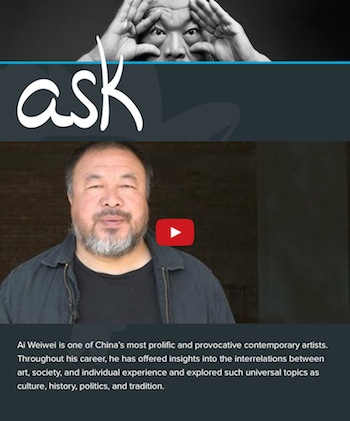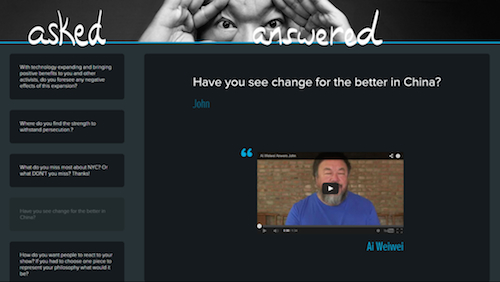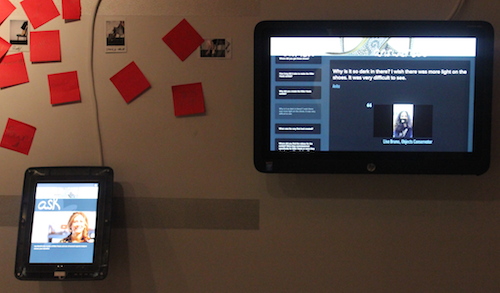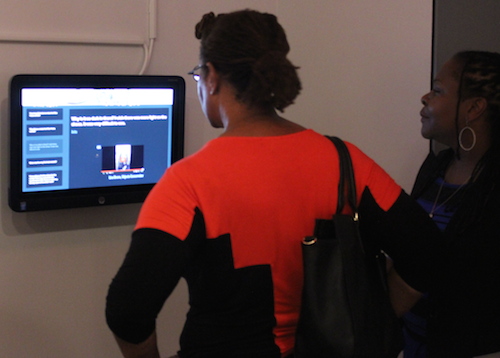Metrics Tell (Part of) the Story
As Shelley mentioned in her previous post, we’ve tweaked our comment kiosks over the past year or so, shifting them to an ask functionality only and are exploring their use as part of Bloomberg Connects. Just like the other components of this project thus far, visitor behavior is driving our changes.

Metrics can tell a story, but they are often not enough.
One of our windows into visitor behavior is metrics. In the case of our ipad kiosks, up until now at least, this is a pretty small window. The metrics we were able to gather were limited to Google Analytic tracking and YouTube’s own analytics package. Taking last season’s Ai Weiwei and Swoon kiosks as an example, we know how many questions were asked and how many times someone pressed play on the video prompt or the response videos. What we don’t know is if a person was pressing play in the gallery or online because the videos were hosted on YouTube and then embedded into the ASK interface. In addition to being shown in the gallery on the iPad, the video prompt and responses are also available on the exhibition’s webpage. YouTube statistics tell us how many times a video was watched, but we don’t know if this is an online on in-gallery viewing. And of course metrics also can’t tell us how many videos one person may have watched or if the people posing questions are the same as those reviewing answers.

Observation showed us that visitors often use the kiosks in social groups.
To begin to get answers to these questions, our Digital Community Liaison, Brooke Baldeschwiler, spent time in the galleries observing and speaking with visitors in the Ai Weiwei and Swoon exhibitions. From this, we were able to determine that there are two fairly distinct user groups—the question posers and the response reviewers. In fact, observation was showing us that most visitors used the kiosks to review answers. Reasons for this varied and included not having time, not having a question, or seeing the answer to their question already posted. Brooke also determined that multiple visitors use the kiosks at once. This falls right in line with visitor behavior in general; we have a social bunch here (most of our visitors come in pairs and small groups) and they like to experience the museum together. Looking at these stats and their limitations and armed with a better understanding of use through observation and interviews, we have updated our approach for the ASK kiosks this exhibition season in a number of key ways.

The iPads remain the place to pose your question, but we’ve added a companion touchscreen that will show the answered questions.
First, we divided the experience into ask and answers. The iPads remain the place to pose your question, but we’ve added a companion touchscreen that will show the answered questions. This not only caters to the two user groups and social use we’ve identified through observation, but also allows us to get more specific metrics because the new design allows us the ability to track when an answer is read. We can now get a greater sense of the overall participation from askers to readers. Additionally, putting the answers on a larger screen is a very preliminary form of prototyping for future digital signage, which we plan to eventually deploy as part of this project. We’re not really sure what kinds of content will encourage people to approach and touch and this will give us some early insight into those motivations. We’ll be showing answers in both video and text format and can begin to see what visuals and what content draw people in.

In our new setup the ipad is where you ask your question, but we’ve paired with a larger touchscreen which displays the answers.
This season we’re also tracking the play button so we’ll be able to see how many people watch the videos and if that play button was pressed in-gallery or online. We’ll be able to see how much of each video they watch, which will help us get a feel for good video length. Of course, we’ll still be tracking how many people leave questions and be able to compare that to the number of people watching the video, so we’ll know how many answered our call to action.

Observation has shown us that those who ask and those who read are different audiences; the larger screen of answers helps facilitate the readers.
However, metrics still won’t tell us who is pressing play. We’ll be doing more observation to learn that. Observation will also give us an idea of the stay rate at the kiosks, how much content users delve into, and what general user experience is like. Is the function of each component (iPad and touchscreen) clear? Easy to navigate? Is the content compelling? We’ll also do some interviews to help answer those questions. That’s really one of my personal key learnings from this project—to get the real story, you have to pair metrics with observation and audience evaluation. We’ll continue to use both as the project unfolds.

Sara Devine joined the Brooklyn Museum as Manager of Interpretive Materials in 2011 and is now Director of Visitor Experience & Engagement. A vocal visitor advocate, her expertise lies in crafting accessible and engaging visitor experiences and reaching audiences across platforms. She works with curators, designers, educators, technologists, and editors on all aspects of visitor experience and engagement. Sara is also a visiting assistant professor and curriculum coordinator at Pratt Institute’s School of Information for their graduate program in Museums and Digital Culture. She was previously Senior Content Developer and Project Manager at Hilferty, a museum planning and design firm in Ohio, where she developed comprehensive interpretive master plans and exhibitions for a wide variety of museums. She has also worked at Assistant Curator, Special Exhibition at Thomas Jefferson’s Monticello and as a Curatorial Assistant at the Smithsonian Museum of Natural History.


Seb Chan - 9 years ago
Back in Powerhouse days, Carlos Arroyo (now at Dallas Museum of Art) was looking into using the camera on tablet kiosks to detect when visitors were standing in front of them (or not). Apart from being kind of creepy, there may be ways you can use the camera as a sensor to detect and measure when people are interacting with the kiosk . . .
Sara Devine - 9 years ago
We have thought about using the cameras, though not for that purpose–it’s totally creepy. We also think it’s unnecessary if the design gathers the analytics we need. We have considered using the camera feature to allow visitors to attach a photo of themselves to their question (the Tate does this as part of their Bloomberg Connects implementation), but any use of the camera will be at the visitor’s discretion.